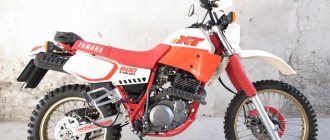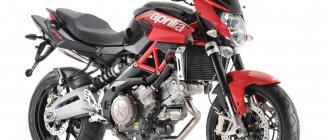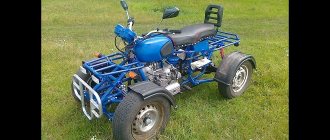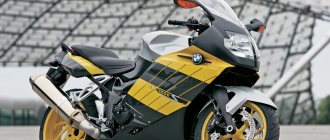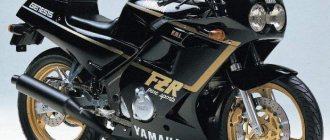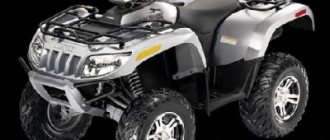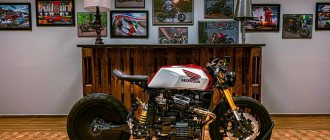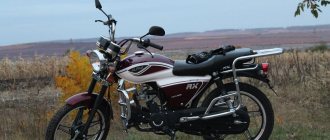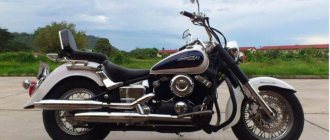History of "Dnepr"
You will be interested in:Which is better - Kia Spectra or Hyundai Accent: comparative characteristics, car descriptions, owner reviews
The first motorcycle under the Dnepr brand was released back in 1950. The last one from the “Chopper” series rolled off the assembly line in 1992. In 2000, they tried to revive production; a special modification of the motorcycle was created, which was supposed to be exported, but in the end less than three dozen such models were produced, which were later transferred to the Ukrainian motorized regiment, and the project was canceled. Now the plant is being converted into a business center, the equipment is being handed over to a scrap metal collection point, we can say that an attempt at another revival will not take place with almost a hundred percent probability.
You may be interested in: Utility-passenger "Sable": review, characteristics, price
Differences between Dnepr and Ural engines
Differences between Dnepr and Ural engines
Post by Demon » Sep 22, 2010, 11:01 am
Ural crankshaft: composite crankshaft, non-separable, roller bearings of the lower connecting rod head. The advantages of this design are relative survivability in case of lubrication system malfunctions and undemandingness to oil pressure.
Dnepr: the crankshaft is solid, the bearings of the lower heads of the connecting rods are on liners (sleeve bearings), the connecting rods are detachable - like on cars.
Lubrication system To clean oil on the Dnieper, a centrifuge is used, separating dirt particles from the oil due to centrifugal force, but it only works well at high crankshaft speeds.
In the Urals, a cardboard oil filter is installed to purify oil. Parallel to it there is a pressure reducing valve that allows oil to bypass the filter if it is clogged or the oil is thick.
The oil systems of the Dnieper and the Urals also differ in the performance of the pump and its location and drive - in the Dnieper it is a special gear from the crankshaft, in the Urals - from the rear of the camshaft with a helical gear and a roller. The pumps themselves are almost identical, the difference is in their rotation speed. The Dnieper pump is equipped with a pressure reducing valve that prevents pressure from increasing above the permissible level. This valve tends to become clogged, which leads to an emergency drop in pressure. To monitor the oil pressure on the Dnepr there is a warning lamp.
Cylinders In the Urals, both aluminum with a liner and cast iron were used. On the Dnieper they are aluminum, with a sleeve poured into it - you cannot press it out, only cut it out. Aluminum has a greater ability to dissipate heat. Attachment to the crankcase at the Dnepr - studs through the cylinder and head. In the Urals - with short pins for the flange. Ural and Dnieper are not interchangeable. The Ural ones have pressed pusher rod casings; on the Dnepr they go into the head.
Cylinder heads are not interchangeable. Valve covers are oval in the Urals and closer to rectangular in the Dnieper.
Carburetors and electrical equipment are interchangeable.
Tuning options
Due to the closure of the Kyiv Motorcycle Plant, the modernization and modification of this motorcycle equipment has been suspended. In this regard, all improvements have to be done with your own hands or contact private specialists.
Tuning areas
The exhaust system, front fork, roll bar, footrest, and windshield are most in need of replacement. Forks, footrests and other body parts are replaced with chrome-plated counterparts.
When the exhaust system is modernized, they often install nickel-plated elbows and a direct-flow muffler. Such replacements will improve engine performance and make it sound better. Some motorcyclists, instead of reverse gear, provide the device with an additional gear in order to increase the dynamics of the motorcycle.
In the video below you can see step-by-step instructions for converting a standard gearbox into a five-speed one:
The ignition system requires modification. For this purpose, the motor vehicle is equipped with an electric starter for automatic engine start and contactless ignition. The most effective effect will be replacing the engine with a new, more powerful one. Such changes will cost a significant amount because the new engine comes with additional parts and equipment.
Appearance
Due to the large dimensions of the motorcycle, in order to give it dynamism and update its external qualities, they resort to replacing some parts of the body in the form of standard shock absorbers, steering gear, footpegs, forks and other parts with lighter analogues. Often, to update the appearance, parts are repainted in a different color.
Engine tuning
During the modernization process, the motor must be thoroughly cleaned. The exhaust system is equipped with various nickel rings and a forward flow system. These actions are important not only for aesthetics, but also for engine performance.
If it is not possible to buy nickel-plated parts, then you can contact a specialist to coat the metal parts with nickel.
Frame and body tuning
The frame design of all modifications is similar. The frame at the back can be lengthened (by 15-20 cm) to give your legs more freedom. In this case, it is also necessary to lengthen the driveshaft - then the frame is lengthened in accordance with the height of the driver.
To get a similar fit to classic American choppers, you need to lengthen the frame at the front. Then the cardan shaft does not change, you just need to redo the pedals.
The tuning capabilities of the Dnepr motorcycle are demonstrated in this video:
Many owners of the Dnepr motorcycle have a special affection for it and, despite the huge selection of modern motorcycle equipment, are not going to change their preferences. Now there are many opportunities to update a vehicle by tuning it.
Engine disadvantages
The Dnepr engine, unlike the Ural engine, has several critical disadvantages:
- The absence of an oil filter in the engine does not ensure cleaning of the oil in the lubrication system;
- Air cooled. Often, such cooling may not be enough to ensure the desired temperature, especially in off-road conditions.
- Prone to overheating. Requires constant monitoring of the oil level, which it likes to consume or “spit out” into the breather;
- In terms of design solutions, the Dnepr engine has a number of shortcomings. The bottom line is that, for unknown reasons, there is no oil filter in the engine; instead there is a so-called centrifuge (centrifugal filter). When centrifugal oil filters are used in car engines, they are installed after coarse oil filters, where they act as fine filters. To put it briefly and clearly, this is a round-shaped part that stands in the engine, it rotates and oil gets into it, there, according to the engineers’ idea and the laws of physics, all the dirt, by inertia, should remain on the walls of this centrifuge and filtered clean oil should be supplied further to the oil system . In practice, some dirt still gets into the lubrication system, shortening the life of the engine. Since the oil channels become clogged, in particular in the crankshaft itself, preventing oil from reaching the crankshaft liners and all this is fraught with critical breakdowns. The Dnepr’s oil system needs improvement, which is what motorcycle owners do on their own, otherwise you’ll just end up with crankshaft liners turning. Therefore, it is recommended to change the engine oil more often;
- Also, according to owners, there are manufacturing defects in the form of a gap between the front engine cover and the crankshaft. This defect leads to the removal of most of the oil into the sump; accordingly, less of it reaches the crankshaft liners;
- The gearbox does not offer excellent smoothness and precision of gear changes. You need to change gears very carefully, otherwise you can simply switch from one speed to another without noticing;
- One cannot fail to note such an important drawback in our time as the relatively high fuel consumption. If you don’t improve the power supply system, it will cost you money, because in the days of the USSR, when fuel really cost a penny, little things like gasoline consumption bothered few people;
- Requires frequent maintenance. Dnepr motorcycle engines require more frequent maintenance compared to car engines. List of work that must be performed during engine maintenance: checking and adjusting valves (thermal clearances), replacing engine oil and oil filter, monitoring the condition of spark plugs;
- Difficulty in maintenance and rather low reliability of the entire system will be the main disadvantages of this engine;
- The pressure reducing valve installed in the pump is located in the crankcase above the oil level; filling it with oil itself is not possible in case of clogging, because the valve does not fit tightly to the seat. Valve cleaning is time-consuming because it also involves disassembling the engine;
- Moreover, it has relatively small output figures: 26 and 32 horsepower, depending on the internal combustion engine model;
- In addition, the engine often suffers from the pins being too tightly seated in the piston, which leads to overheating of the cylinders and heads.
